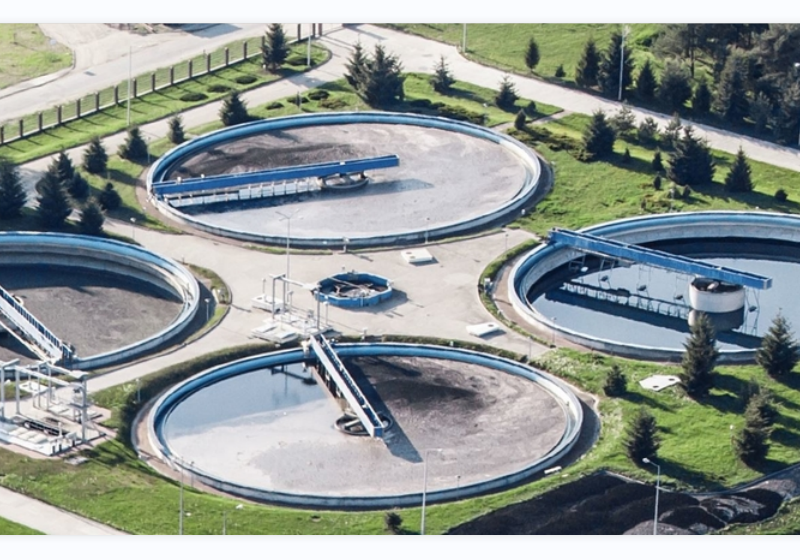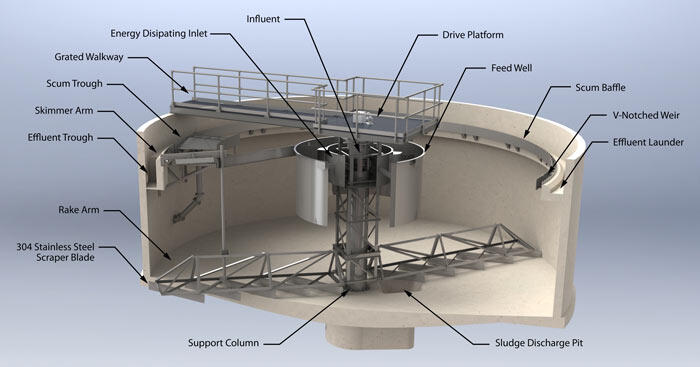Common problems of secondary sedimentation tank
PROBLEM:Low Dissolved Oxygen(DO) In The Effluent Of Secondary Sedimentation Tank
CAUSE1: The activated sludge stays in the secondary sedimentation tank for a long time, and the aerobic microorganism in the sludge continues to consume oxygen, resulting in the decrease of dissolved oxygen in the effluent of the secondary sedimentation tank.
SOLUTION: Increase the amount of returned sludge and shorten the retention time.
CAUSE 2: The sludge suction (scraping) machine is not in good working condition, which causes the partial sludge in the secondary sedimentation tank to not return in time, and some sludge stays in the secondary sedimentation tank for a long time. The aerobic microorganism in the sludge continues to consume oxygen, resulting in the decrease of dissolved oxygen in the effluent of the secondary sedimentation tank.
SOLUTION: Repair the mud suction (scraping) machine in time to restore it to normal working condition.
CAUSE 3: The sudden rise of water temperature increases the oxygen consumption of aerobic microorganism physiological activities, and strengthens the activity of anaerobic microorganism in local anoxic zone, resulting in the decrease of dissolved oxygen in the effluent of secondary sedimentation tank.
SOLUTION: Try to prolong the residence time of sewage in pretreatment facilities such as homogenization regulation, make full use of the volume of the regulation tank to circulate high-temperature water, or reduce the temperature by strengthening pre-aeration to promote water vapor evaporation.
PROBLEM:Sudden Increase Of BOD and COD In Effluent Of Secondary Sedimentation Tank
CAUSE 1: The amount of sewage entering the aeration tank suddenly increases, the organic load suddenly increases, or the concentration of toxic and harmful substances suddenly increases.
SOLUTION: Strengthen the monitoring of sewage quality and give full play to the role of regulating tank to make the inflow as balanced as possible.
CAUSE 2: Poor management of aeration tank (such as insufficient aeration oxygen filling, etc.), resulting in sudden rise of effluent.
SOLUTION: Strengthen the management of aeration tank and adjust various operating parameters in time.
CAUSE 3: Poor management of secondary sedimentation tank (such as untimely cleaning of scum, abnormal operation of mud scraper, etc.).
SOLUTION: Strengthen the management of secondary sedimentation tank, timely patrol inspection, and immediately rectify problems found.
QDEVU® Peripheral/Central Drive Sludge Scraper For Sedimentation Tank
PROBLEM:Sludge Floating In Secondary Sedimentation Tank
Sludge floating in the secondary sedimentation tank refers to the phenomenon that sludge floats to the surface of the secondary sedimentation tank due to acidification or denitrification of sludge in the secondary sedimentation tank. The floating sludge itself has no quality problems, and its biological activity and sedimentation performance are normal.
The main reason for floating is that these normal sludge stay in the secondary sedimentation tank for a long time, acidification occurs due to the gradual consumption of dissolved oxygen, and new H2S and other gases are generated to attach to the sludge flocs, which reduces its density and causes the sludge to float up. When the SRT of the system is long, after nitrification, the mixed liquid entering the secondary sedimentation tank will contain a large amount of nitrate. The sludge in the secondary sedimentation tank will undergo denitrification due to the lack of sufficient dissolved oxygen (DD<0.5 mg/L). The N2 produced by denitrification will also attach to the sludge floc, reducing its density and causing the sludge to float up.
The measures to control the floating of sludge are as follows: first, timely discharge the surplus sludge and increase the amount of returned sludge, so as not to make the sludge stay in the secondary sedimentation tank for too long; The second is to strengthen the oxygen filling at the end of the aeration tank, increase the dissolved oxygen content in the mixed liquid entering the secondary sedimentation tank, and ensure that the sludge in the secondary sedimentation tank is not in anaerobic or anoxic state. For the sludge floating caused by denitrification, it can also increase the discharge of excess sludge, reduce SRT, and control denitrification by controlling the degree of nitrification.
#QDEVU #WATERTREATMENT #WASTEWATERTREATMENT #SEWAGETREATMENT #SEWAGEWATERTREATMENT #BIOLOGICALTREATMENT #ACTIVEDSLUDGE
Visit www.evuchina.com for more informations!




